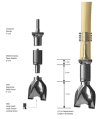Compressive osseointegration for endoprosthetic reconstruction
- PMID: 33312488
- PMCID: PMC7726822
- DOI: 10.4081/or.2020.8646
Compressive osseointegration for endoprosthetic reconstruction
Abstract
This review summarizes the biomechanical concepts, clinical outcomes and limitations of compressive osseointegration fixation for endoprosthetic reconstruction. Compressive osseointe - gration establishes stable fixation and integration through a novel mechanism; a Belleville washer system within the spindle applies 400-800 PSI force at the boneimplant interface. Compressive osseointegration can be used whenever standard endoprosthetic reconstruction is indicated. However, its mode of fixation allows for a shorter spindle that is less limited by the length of remaining cortical bone. Most often compressive osseointegration is used in the distal femur, proximal femur, proximal tibia, and humerus but these devices have been customized for use in less traditional locations. Aseptic mechanical failure occurs earlier than with standard endoprosthetic reconstruction, most often within the first two years. Compressive osseointegration has repeatedly been proven to be non-inferior to standard endoprosthetic reconstruction in terms of aseptic mechanical failure. No demographic, device specific, oncologic variables have been found to be associated with increased risk of aseptic mechanical failure. While multiple radiographic parameters are used to assess for aseptic mechanical failure, no suitable method of evaluation exists. The underlying pathology associated with aseptic mechanical failure demonstrates avascular bone necrosis. This is in comparison to the bone hypertrophy and ingrowth at the boneprosthetic interface that seals the endosteal canal, preventing aseptic loosening.
Keywords: Biomet Compress; Compressive osseointegration; bone loss; endoprosthetic reconstruction; limb salvage surgery.
©Copyright: the Author(s).
Figures
References
-
- Bini SA, Johnston JO, Martin DL. Compliant prestress fixation in tumor prostheses: interface retrieval data. Orthopedics 2000;23:707-11; discussion 11-2. - PubMed
LinkOut - more resources
Full Text Sources



